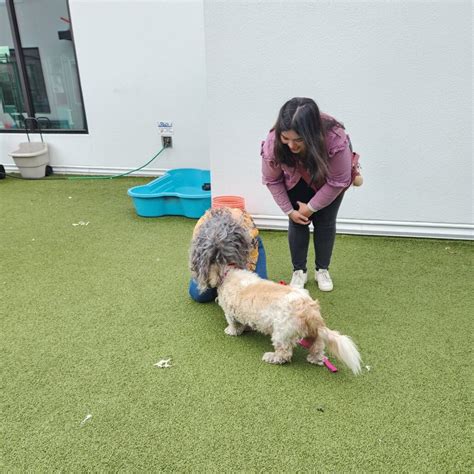
A heartwarming video capturing the unexpected reunion of two young dogs with their owner after they believed they were simply going for a walk has gone viral, showcasing the pups’ exuberant joy and tail-wagging excitement. The video, shared on social media, depicts the dogs’ overwhelming happiness as they realize their beloved “dad” is back, eliciting an outpouring of emotional responses from viewers worldwide.
The video, originally posted by the dogs’ owner, shows the canines being led to believe they were embarking on a routine walk. However, the surprise element came when they were reunited with their owner, who had been away. The footage showcases their ecstatic reaction, filled with bounding leaps, happy yelps, and non-stop tail wags, capturing a truly touching moment of canine affection. “It’s a priceless display of pure joy,” as one commenter noted on social media, reflecting the general sentiment of viewers moved by the scene. The video’s widespread appeal lies in its ability to resonate with pet lovers and anyone who appreciates heartwarming displays of affection and the strong bonds between humans and animals. The dogs’ reaction serves as a reminder of the unwavering loyalty and unconditional love that pets offer, making the reunion all the more poignant and memorable. The visual evidence of their delight and uncontained enthusiasm highlights the emotional depth of animals and the significant role they play in their owners’ lives. The moment emphasizes the simple yet profound joy that pets bring, showcasing how even brief separations can intensify the bonds we share with them. The viral video has not only entertained but also reinforced the understanding of the emotional intelligence of dogs, captivating hearts and minds across the internet.
The viral sensation highlights the intense bond between humans and their canine companions. Experts in animal behavior suggest that dogs possess a deep understanding of human emotions and can form incredibly strong attachments to their owners. Dr. Emily Weiss, VP of Research & Development at the ASPCA, emphasizes the importance of these relationships: “The bond between people and their pets is a powerful one. It can be a source of comfort, companionship, and unconditional love.” The dogs’ reaction in the video exemplifies this bond, underscoring the emotional connection and the significant impact of human presence on their well-being.
The video quickly gained traction, amassing millions of views and shares across various social media platforms. Users flooded the comments section with messages of admiration and empathy, praising the dogs’ display of affection and the owner’s thoughtful surprise. The widespread attention has also sparked discussions about pet adoption and the importance of providing loving homes for animals in need. Several animal welfare organizations have used the video’s popularity to promote their cause, encouraging potential pet owners to consider adoption as a means of providing a second chance to deserving animals. The video serves as a powerful reminder of the joy and fulfillment that pets can bring into our lives, prompting many to reflect on their own relationships with their animal companions.
Moreover, the video has contributed to a broader conversation about the emotional intelligence of dogs. Research increasingly suggests that dogs are capable of experiencing a wide range of emotions, including joy, sadness, and even empathy. Studies have shown that dogs can recognize human facial expressions and respond accordingly, indicating a sophisticated level of emotional awareness. The dogs’ reaction in the video further supports this notion, demonstrating their ability to express profound happiness and excitement upon being reunited with their owner. This understanding has significant implications for how we treat and care for our canine companions, emphasizing the importance of providing them with a loving and stimulating environment that meets their emotional needs.
The owner, identified only as a loving pet parent in the original source, intentionally created the surprise reunion to capture their dogs’ genuine reaction. The setup involved leading the dogs to believe they were going on a regular walk, only to have their owner appear unexpectedly. The result was a heartwarming display of unfiltered joy that resonated with viewers around the world. The decision to share the video on social media was driven by a desire to spread positivity and highlight the special bond between humans and their pets. The owner’s thoughtful gesture has not only brought smiles to countless faces but also served as a reminder of the profound impact that animals can have on our lives. The video’s success underscores the power of social media to connect people through shared experiences and emotions, fostering a sense of community and appreciation for the simple joys of life.
The impact of the video extends beyond mere entertainment. It has also prompted discussions about responsible pet ownership and the importance of providing animals with a safe and nurturing environment. Animal welfare advocates have used the video’s popularity to raise awareness about the needs of pets and the importance of addressing issues such as abandonment and neglect. The video serves as a powerful reminder that pets are not simply possessions but sentient beings with emotional needs that must be met. By showcasing the joy and love that pets can bring into our lives, the video encourages viewers to consider the responsibilities that come with pet ownership and to commit to providing their animal companions with the best possible care.
Additionally, the video has sparked a renewed interest in research on canine behavior and cognition. Scientists are increasingly studying the emotional lives of dogs, seeking to understand the neural mechanisms that underlie their capacity for joy, sadness, and attachment. This research has the potential to shed light on the evolution of emotions and the complex relationships between humans and animals. By providing a window into the emotional world of dogs, the viral video has contributed to a broader understanding of the unique bond between humans and their canine companions. The attention garnered by the video underscores the importance of continued research in this area and the potential for new discoveries that can enhance our understanding of animal behavior and cognition.
The video’s widespread appeal also reflects a growing recognition of the therapeutic benefits of pet ownership. Studies have shown that interacting with pets can lower blood pressure, reduce stress, and improve overall well-being. The unconditional love and companionship that pets offer can be particularly valuable for individuals struggling with mental health issues such as depression and anxiety. The viral video serves as a reminder of the positive impact that pets can have on our lives, highlighting their ability to provide comfort, support, and a sense of purpose. The video’s success underscores the importance of recognizing the therapeutic benefits of pet ownership and promoting policies that support the welfare of animals.
The video has also inspired numerous acts of kindness and generosity towards animals in need. Many viewers have been moved to donate to animal shelters and rescue organizations, while others have volunteered their time to care for animals in their communities. The viral video has served as a catalyst for positive change, prompting individuals to take action and make a difference in the lives of animals. The outpouring of support demonstrates the power of social media to mobilize people around a common cause and to inspire acts of compassion and generosity. The video’s success underscores the importance of using social media as a tool for promoting animal welfare and advocating for the rights of animals.
In conclusion, the viral video of the dogs’ tail-wagging reunion with their owner is more than just a heartwarming moment; it is a testament to the profound bond between humans and animals, the emotional intelligence of dogs, and the power of social media to connect people and inspire positive change. The video’s widespread appeal reflects a growing appreciation for the role that pets play in our lives and a renewed commitment to ensuring their well-being. The video serves as a reminder of the joy, love, and companionship that pets bring into our lives and the importance of treating them with kindness, respect, and compassion. The impact of the video will likely continue to be felt for years to come, as it inspires countless acts of kindness and generosity towards animals in need and promotes a deeper understanding of the unique bond between humans and their canine companions. The video stands as a lasting symbol of the power of love and connection in a world that often feels disconnected and divided. Its message of hope, joy, and unconditional love resonates with viewers of all ages and backgrounds, reminding us of the importance of cherishing the relationships we have with our animal companions. The legacy of the viral video will undoubtedly be one of compassion, understanding, and a renewed commitment to promoting the welfare of animals around the world. The simple act of capturing and sharing this heartwarming moment has had a profound impact, demonstrating the power of social media to amplify positive messages and inspire acts of kindness and generosity.
Frequently Asked Questions (FAQs)
1. What exactly does the viral video show?
The video depicts two dogs experiencing an unexpected and joyous reunion with their owner after they were led to believe they were simply going for a walk. Their reaction, filled with tail-wagging, jumping, and happy vocalizations, highlights the strong bond between them and their owner. It showcases their unbridled excitement and affection.
2. Why did the video become so popular?
The video’s popularity stems from its ability to evoke positive emotions in viewers. It showcases a heartwarming display of pure joy and unconditional love, which resonates with pet lovers and anyone who appreciates genuine connection. The dogs’ reactions serve as a reminder of the strong bonds between humans and animals.
3. What does the video suggest about the emotional intelligence of dogs?
The dogs’ reaction in the video supports the growing body of research that suggests dogs are capable of experiencing a wide range of emotions, including joy, sadness, and attachment. Their ability to express profound happiness upon being reunited with their owner indicates a sophisticated level of emotional awareness and a deep connection to their human companions. Dr. Emily Weiss emphasizes the importance of these relationships: “The bond between people and their pets is a powerful one. It can be a source of comfort, companionship, and unconditional love.”
4. How has the video been used to promote animal welfare?
Animal welfare organizations have used the video’s popularity to raise awareness about pet adoption and the importance of providing loving homes for animals in need. It serves as a powerful reminder of the joy and fulfillment that pets can bring into our lives, prompting many to consider adoption and responsible pet ownership.
5. What is the long-term impact of the video?
The long-term impact of the video is multifaceted. It has inspired acts of kindness and generosity towards animals, promoted a deeper understanding of canine behavior and cognition, and reinforced the therapeutic benefits of pet ownership. The video stands as a lasting symbol of the power of love and connection, reminding us of the importance of cherishing the relationships we have with our animal companions. The visual evidence of their delight and uncontained enthusiasm highlights the emotional depth of animals and the significant role they play in their owners’ lives. The moment emphasizes the simple yet profound joy that pets bring, showcasing how even brief separations can intensify the bonds we share with them. The viral video has not only entertained but also reinforced the understanding of the emotional intelligence of dogs, captivating hearts and minds across the internet.
The attention garnered by the video underscores the importance of continued research in this area and the potential for new discoveries that can enhance our understanding of animal behavior and cognition. The owner’s thoughtful gesture has not only brought smiles to countless faces but also served as a reminder of the profound impact that animals can have on our lives. The video’s success underscores the power of social media to connect people through shared experiences and emotions, fostering a sense of community and appreciation for the simple joys of life. It also prompted discussions about responsible pet ownership and the importance of providing animals with a safe and nurturing environment. Animal welfare advocates have used the video’s popularity to raise awareness about the needs of pets and the importance of addressing issues such as abandonment and neglect. The video serves as a powerful reminder that pets are not simply possessions but sentient beings with emotional needs that must be met. The outpouring of support demonstrates the power of social media to mobilize people around a common cause and to inspire acts of compassion and generosity. The video’s success underscores the importance of using social media as a tool for promoting animal welfare and advocating for the rights of animals.
Expanded Content and In-Depth Analysis
The impact of this video extends far beyond a simple viral sensation. It touches on several critical aspects of human-animal interaction, societal attitudes towards pets, and the evolving understanding of animal cognition and emotion. To fully appreciate the significance of this event, it’s necessary to delve into these areas more deeply.
The Evolving Understanding of Canine Cognition and Emotion
For centuries, the scientific community debated the extent to which animals, particularly dogs, possessed genuine emotions and cognitive abilities. Early theories often portrayed animals as mere instinct-driven beings, lacking the capacity for complex thought or feeling. However, advancements in neuroscience and behavioral research have gradually challenged this view, revealing a far more nuanced and sophisticated picture of the canine mind.
Studies employing techniques such as functional magnetic resonance imaging (fMRI) have demonstrated that dogs’ brains respond to stimuli in ways remarkably similar to human brains. For example, research has shown that dogs exhibit increased activity in brain regions associated with positive emotions when exposed to the scent of their owners or when receiving praise. These findings provide compelling evidence that dogs are not simply reacting to stimuli in a mechanical way but are genuinely experiencing emotions akin to those felt by humans.
Furthermore, behavioral studies have revealed a range of cognitive abilities in dogs, including the capacity for problem-solving, social learning, and even deception. Dogs have been shown to understand human cues, such as pointing gestures and vocal commands, with a level of sophistication that rivals that of young children. They can also learn to associate words with objects and actions, demonstrating a rudimentary understanding of language.
The viral video of the dogs’ reunion with their owner provides further anecdotal evidence of the emotional depth and cognitive abilities of canines. The dogs’ unbridled joy and enthusiastic displays of affection suggest a deep emotional connection to their owner and a clear understanding of the significance of his return. Their behavior cannot be easily explained as mere instinctual response; it reflects a complex interplay of emotions, memories, and social understanding.
The Role of Pets in Human Society and Well-being
Pets, particularly dogs and cats, have long held a special place in human society. For millennia, they have served as companions, working partners, and sources of emotional support. In modern times, the role of pets has become even more prominent, with many individuals and families viewing them as integral members of their households.
Research has consistently demonstrated the positive impact of pet ownership on human well-being. Studies have shown that interacting with pets can lower blood pressure, reduce stress hormones, and increase levels of endorphins, the body’s natural mood boosters. Pet ownership has also been linked to decreased feelings of loneliness and isolation, particularly among elderly individuals and those living alone.
The therapeutic benefits of pet ownership are increasingly recognized in the field of mental health. Animal-assisted therapy (AAT) is now widely used as a complementary treatment for a variety of conditions, including depression, anxiety, post-traumatic stress disorder (PTSD), and autism spectrum disorder (ASD). AAT involves the use of trained animals, typically dogs, to provide emotional support and therapeutic interaction for individuals in need.
The viral video of the dogs’ reunion highlights the profound impact that pets can have on human lives. The dogs’ unconditional love and unwavering loyalty serve as a reminder of the simple joys and emotional connections that can enrich our lives. Their presence provides comfort, companionship, and a sense of purpose, making them invaluable members of our families and communities.
Ethical Considerations of Pet Ownership
While the benefits of pet ownership are undeniable, it’s important to acknowledge the ethical responsibilities that come with caring for animals. Pets are not simply possessions; they are sentient beings with their own needs, desires, and feelings. Responsible pet ownership requires a commitment to providing animals with a safe, healthy, and stimulating environment that meets their physical, emotional, and social needs.
This includes providing adequate food, water, shelter, and veterinary care. It also entails ensuring that pets receive sufficient exercise, mental stimulation, and social interaction. Furthermore, responsible pet owners must take steps to prevent their animals from causing harm or nuisance to others. This may involve training, socialization, and responsible containment.
One of the most pressing ethical issues in pet ownership is the problem of animal abandonment and neglect. Millions of animals are abandoned or surrendered to shelters each year, often due to irresponsible breeding practices, unrealistic expectations, or financial hardship. Addressing this issue requires a multi-faceted approach, including promoting responsible pet ownership, supporting animal shelters and rescue organizations, and enacting stricter laws against animal cruelty.
The viral video of the dogs’ reunion serves as a reminder of the profound responsibility that comes with pet ownership. It underscores the importance of treating animals with kindness, respect, and compassion and of committing to providing them with the best possible care. The video also highlights the need for greater awareness and education about responsible pet ownership practices.
The Power of Social Media in Amplifying Human-Animal Connections
Social media has emerged as a powerful tool for connecting people and sharing stories, including those involving animals. The viral video of the dogs’ reunion is a prime example of how social media can amplify human-animal connections and promote positive messages about animal welfare.
By sharing heartwarming stories and images of animals, social media can foster empathy and compassion among viewers. It can also raise awareness about important issues such as pet adoption, animal rescue, and responsible pet ownership. Furthermore, social media can be used to mobilize support for animal welfare organizations and to advocate for stronger animal protection laws.
However, it’s important to acknowledge the potential downsides of social media in the context of animal welfare. The spread of misinformation and harmful content can have negative consequences for animals, such as promoting unethical breeding practices or encouraging the mistreatment of animals for entertainment purposes. Therefore, it’s crucial to use social media responsibly and to be critical of the information we encounter online.
The viral video of the dogs’ reunion demonstrates the power of social media to connect people through shared emotions and experiences. It also highlights the importance of using social media as a tool for promoting animal welfare and advocating for the rights of animals. By sharing positive stories and raising awareness about important issues, we can create a more compassionate and responsible society for all living beings.
The Future of Human-Animal Relationships
As our understanding of animal cognition and emotion continues to evolve, so too will our relationships with animals. In the future, we can expect to see a greater emphasis on ethical treatment, responsible pet ownership, and the recognition of animal rights.
Advances in technology may also play a role in shaping human-animal interactions. For example, wearable sensors and artificial intelligence could be used to monitor animal health and behavior, allowing for earlier detection of illness or distress. Virtual reality and augmented reality could also be used to create more engaging and enriching experiences for animals, particularly those living in confined environments.
Furthermore, we can expect to see a growing recognition of the importance of animal welfare in various industries, such as agriculture, research, and entertainment. Consumers are increasingly demanding products and services that are produced in a humane and ethical manner, and businesses are responding by adopting more sustainable and animal-friendly practices.
The viral video of the dogs’ reunion serves as a reminder of the enduring bond between humans and animals. It also highlights the potential for a future in which animals are treated with greater respect, compassion, and understanding. By embracing ethical principles and leveraging technological advancements, we can create a world in which both humans and animals thrive.









